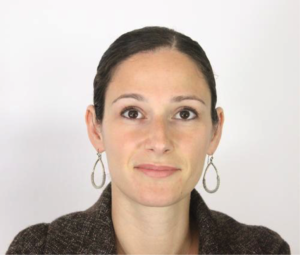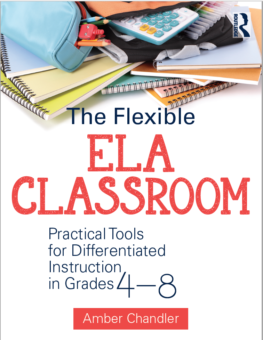Energizing Ideas for a Flexible ELA Classroom
The Flexible ELA Classroom: Practical Tools for Differentiated Instruction in Grades 4—8
By Amber Chandler
(Routledge/Eye on Education, 2016 – Learn more)
 Reviewed by Ariel Sacks
Reviewed by Ariel Sacks
Differentiation is one of those education buzzwords that has made a niche for itself in schools for some time now – often as one more “must do” for teachers, on top of everything else! At its best, though, differentiation is a lifesaver for students and helps to create a thriving learning space for everyone involved, including teachers.
That is just the kind of classroom Amber Chandler, a National Board Certified 8th grade English teacher, shares in her book, The Flexible ELA Classroom: Practical Tools for Differentiated Instruction in Grades 4-8.
 If you’re an English teacher thinking about how to bring your practice to the next level, this book will be an inspiring and user-friendly resource for you. If you’re wary of differentiation becoming another way to divide and sort students, Flexible ELA will be a welcome antidote to that common pitfall of data-driven instruction.
If you’re an English teacher thinking about how to bring your practice to the next level, this book will be an inspiring and user-friendly resource for you. If you’re wary of differentiation becoming another way to divide and sort students, Flexible ELA will be a welcome antidote to that common pitfall of data-driven instruction.
I really enjoyed reading this book for several reasons. It’s short, which is a huge plus for busy teachers! It’s practical, with concrete tools that are immediately usable in my classroom.
And finally, Amber’s writing style is personal and readable. Through her book, I get to know an enthusiastic, skilled teacher, who has taken many of the best current teaching trends and made them her own in the English classroom.
Here’s a rundown of what the book includes
In Chapter 1, “Options and Choice: The Heart of Differentiation,” Chandler lays out the go-to techniques she uses to offer students different options in their learning, such as choice boards, menus, tic-tac-toe, and more. Each technique is accompanied by an example from her classes and tied to specific Common Core standards. Many of the materials she shares can be borrowed directly and used right away in your own classroom.
In Chapter 2, “Strategic Groupings: Flexibility for Student Engagement,” we learn how Amber creates different kinds of groups for different activities. She uses a variety of data sources, including student input, to facilitate groups that support the learning task. It’s really helpful to get a picture of how this works for her.
Chapter 3, “Word Study: Personalizing Vocabulary,” focuses on that thorny question for English teachers of how to approach word meanings. Chandler uses a variety of techniques, from explicit instruction of words found in literary texts, to teaching classical roots and affixes, to – later in the year – training students to select and study words on their own and teach one another. She devotes more time to vocabulary than I currently do, but I have to say, her enthusiasm is contagious.
In Chapter 4, Amber shares her approach to the popular concept of “Project Based Learning: Differentiating Student Learning Experiences.” She discusses her thinking about PBL and shares some strong examples – one tied to a whole class study of the novel The Giver and another in which students research “their passion” and present it.
The project examples are tied to specific Common Core standards. She shares assignment sheets, rubrics, and steps along the way, which help students be successful. There is nice integration of technology into the practices in this chapter, and Amber is thoughtful about framing technology as a vehicle for students to move toward a goal, and not the goal itself.
Assessment that values the individual
The title to Chapter 5,“Assessment: Valuing the Individual in a Standardized World,” is perfect. In this chapter, we hear from an experienced, effective teacher about how she thinks about grading, assessment, and standardized testing. Chandler emphasizes that this is about getting students to do their best work and show what they know.
She discusses some of the complex questions around grading and equity for all students. Though she doesn’t offer answers to all of them, it’s helpful to hear about these challenges, which no teacher is above – and it’s clear that the practices in this book will help teachers create more inclusive and equitable classrooms.
Finally, Chapter 6 is about “Family Partnerships: Creating a Customized ‘Dream Team’ for Students.” Chandler shares useful samples of her welcome letter to families and a survey she asks them to fill out about their child in return, as well as how she uses the information she receives. She shares actual email messages she has sent home to individual students. Teachers often hear how important it is to send positive emails home, but it’s so much more helpful to see this in action, as we do here. We also get some good advice on making the most of parent teacher conferences.
Lots of helpful ideas
There is so much to appreciate in The Flexible ELA Classroom. For me, as an experienced ELA teacher, there are a number of strategies I’m eager to try out in my own classroom, as well as ideas that sparked my thinking.
One example of something I want to try is Amber’s method of observing students in the beginning of the year to create what she calls “resource groups,” or thoughtfully determined home base groups. Since her flexible structures have students working within a variety of different teams, even within a single class period, these are the groups they will return to after special activities.
It was the observation piece in Amber’s process that captured my special attention. To create the “resource groups,” she starts the year without assigning any seats; she takes notes on how students respond, where they place themselves, and their work habits, including strengths and weaknesses. Then she creates the home base groups with this knowledge in mind.
I’ve never tried this. Instead, I usually surprise students by having arbitrarily assigned seats from day 1, and then adjusting them based on the unit or activity. I’m eager to see how Amber’s strategy will change how I get to know my students in the beginning of the year and what kinds of things I focus on as I create and utilize those groups later. Explicitly naming students as resources to one another brings a positive and productive tone to an area of my teaching I maybe haven’t thought enough about.
New teachers may want to pace themselves
The above example brings me to one hesitation I want to share, and that is about brand new teachers using this book. There is a ton in here that new teachers will be able to use right away – especially with all of the examples. But some of the techniques will be more successful for teachers who already have some experience teaching ELA.
Starting the year as a brand new teacher with no assigned seats in order to observe students, for example, might not be wise, simply because of the overwhelming number of decisions a new teacher needs to learn to make just to move through a class period.
At the same time, I think new teachers would benefit from reading the book (including this part) and hearing how Amber thinks about teaching. I would just throw a dab of caution to new teachers about adopting too much flexibility before getting their bearings with some of the basics of teaching.
Run and get some mid-year inspiration
For any ELA teacher, including high school, and for teachers of other subjects, I wholeheartedly recommend The Flexible ELA Classroom. In fact, if the middle of the year has got you feeling a bit stagnant or lacking in inspiration – or if you’re drowning in data and want to shake up your thinking about it – run and get a copy of this book.
It will kick you right out of those doldrums and get you and your students excited to learn in new ways.
_____________
Ariel Sacks is in her 13th year as a teacher of English Language Arts in New York City. She now divides her time between teaching 8th graders, writing about teaching and education issues, and supporting teachers to implement student-centered methods, most notably the whole novels approach.
Whole Novels for the Whole Class: A Student Centered Approach is Ariel’s first book. In October 2016 she launched a blog on Education Week called Teaching For the Whole Story, and she is working on a second book about writing in the literature-based classroom. Ariel was a member of the team that co-authored Teaching 2030: What We Must Do For Our Public Schools–Now and in the Future and is featured in the book Teacherpreneurs: Innovative Teachers Who Lead Without Leaving.


































